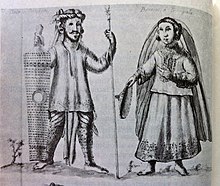

Bahag is a loincloth that was commonly used by men throughout the pre-colonial Philippines. It is worn shirtless with no other extra garments. They were either made from barkcloth or from hand-woven textiles. Before the colonial period, bahag were a common garment for commoners and the serf class (the alipin caste).[1] Bahag survives in some indigenous tribes of the Philippines today - most notably the Cordillerans in Northern Luzon.[2]
- ^ Lopez, Mellie Leandicho (2006). A Handbook of Philippine Folklore. UP Press. p. 385. ISBN 9789715425148.
- ^ Cite error: The named reference
Daltonwas invoked but never defined (see the help page).
© MMXXIII Rich X Search. We shall prevail. All rights reserved. Rich X Search
